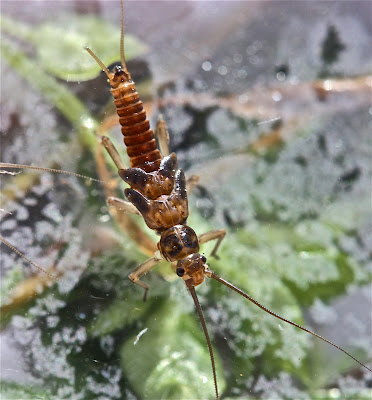Thursday, January 12, 2012
Sifting Away Again in Chloroperlid-ville
I don't know what else to call this little stream that flows into the Moormans. This is the third time I've been here, and every time it's been loaded with Green stonefly nymphs (Chloroperlids) -- genus Sweltsa.
But since Sweltsa species have a TV of 0.2, I guess we shouldn't really complain. Pretty clean water.
But there were other insects today that deserve special attention.
1. The large winter stonefly in the picture above -- Taenionema atlanticum. As you know, I've been finding them in a lot of small streams in the Blue Ridge, but this is the first one that I've seen that is real close to hatching: the wing pads are black, so too is the pronotum. I was disappointed that the one tail was broken, but it still makes a pretty nice photo. A couple more shots.
This is the only large winter species I saw in this stream: no Taeniopteryx burksi, and no Strophopteryx fasciata. But the T. atlanticums were here in force. The others I saw were not quite this mature, but they too photographed well.
2. A Perlodid stonefly -- Isoperla similis.
I found a younger one here back in November (entry posted 11/12): this one is showing its mature colors and patterns, and note how the wing pads are starting to angle and arch (hind edges). Beaty ("The Plecoptera of North Carolina," p. 24) describes the head of I. similis in the following way: "...head brown with a pair of pale spots near labral suture, a pale M-shaped mark anterior to median ocellus and pale marks anterolateral to the lateral ocelli." These features show up best in a microscope photo. (Remember that the little black dots are the ocelli.)
He also notes, "Head and body covered with dark clothing hairs." I think you can make out the hair on the head, and you can clearly see the hair on the mesosternum in this shot I took to show the Isoperla "Y" ridge.
The tolerance value of I. similis is 0.8, another sign that we're dealing with a quality stream.
3. A fingernet caddisfly larva, genus Wormaldia.
This won't look like a fingernet caddis to a lot of my readers: fingernets are yellow or orange, right?
True, for the genus Chimarra (the most common genus we see), but not for the other genera -- Dolophilodes and Wormaldia.
This is the first fingernet caddis I've found in these small streams that feed into the Moormans, and it's the first time I've gotten a live photo of this particular genus. Another look.
How do we know that this is Wormaldia? The three fingernet genera are distinguished -- for the most part -- by the shape of the frontoclypeal apotome (essentially the leading edge of the head). The Chimarra apotome is deeply notched:
The Dolophilodes apotome is asymmetrical with a shallow notch on one side or the other.
And the Wormaldia apotome is symmetrical, but either convex or concave. Ours was concave.
In the new list of tolerance values posted by the North Carolina Department of Water Quality, the tolerance values for these genera are: Chimarra = 3.3; Dolophilodes = 1.0; and Wormaldia = 2.4.
4. Another "odd-looking" freeliving caddisfly larva, Rhyacophila fuscula.
This is the same "lime-green" head that I saw on the freeliving caddis that I found in South River on 1/5. On 1/8, with Steve Beaty's help, I noted that that was probably an early instar of the species Rhyacophila fuscula, which should have a head that looks something like this:
Well, we've got another strange colored head, but on this one, that brown/black "topless H" pattern that shows up on the head of this species is already starting to show. This one was easy to call.
That's about it for today. But, oh yes, there were Chloroperlids crawling around in the leaf packs -- lots of them!
Subscribe to:
Post Comments (Atom)

















No comments:
Post a Comment